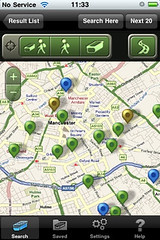The single biggest challenge that marketers face over the next ten years is attention scarcity. Bank on it.
According to Andreas Weigland, Amazon.com's former chief scientist,
more data was generated by individuals in 2009 than in the entire history of mankind. Human attention, however, is finite - and arguably, it shrinks as we age.
The end result is downright ugly. It's like 25 lanes of traffic trying to squeeze through two Lincoln Tunnel tubes during the peak of rush hour. Your marketing programs may be the biggest, baddest bus in the flow, but you're competing with everyone else for the same space and time. Chances are, however, your bus is empty. Park that idea for now. We'll come back to it.
Each individual, whether it's a stay-at-home mom or a twenty-something online addict, will develop his/her own coping mechanisms. Some of these decisions will be conscious. Many of them won't be. And that spells trouble for marketers.
Already one of the ways we're coping is by digging deeper into social networking sites to connect with our friends and interests. According to Nielsen, globally consumers spent more than five and half hours on social networking sites in December. This represents an 82 percent increase year over year. Human beings have always been drawn to each other. Social networking just makes this easier and scalable - or does it?
Robin Dunbar, professor of Evolutionary Anthropology at Oxford University, discovered that
we are only capable of managing 150 friendships - this includes brands. Once again, we're handicapped by our darn brains.
Marketers know they need to be engaged in social networks. Some
45% of senior marketers surveyed by The Society for Digital Agencies said that social network engagement is their top priority. However, many marketers that I speak to don't understand the sheer scale that's required, given the above challenges.
To succeed in a world where attention remains scarce and our brains are limited, businesses must go beyond campaigns and move to real-time engagement. I believe the best way to accomplish this is scale. This means every business must become a social business by deeply integrating their often decoupled employee engagement and digital engagement initiatives.
In short, to revisit the aforementioned metaphor, you must go big, get your employees on the bus, put more buses into the traffic flow or go home.
So what exactly does this look like? It means unshackling your employees. It means equipping them with tools, policies and the means to engage with stakeholders around the clock. Finally, above all, it means allowing your workforce to unlock and share their company and subject-matter expertise.
However, the reality there are very few companies understand this. Most are still taking a campaign approach to social networks where it's the brand, not the people, that are the voice - and there's usually only one.
What's worse, the Berlin Wall stands tall inside Corporate America.
Robert Half Technology found that only 10% of corporate chief information officers grant their employees full access to social networking sites. Those that do probably aren't guiding them.
Manpower reports that only 20 percent of companies have social network policies.
Change must begin at home. If you don't get your employees on buses, your competition will and it will be harder to covet attention. This is every business' challenge in 2010 and beyond.

 OK, so you%u2019re a
OK, so you%u2019re a 







